May 22, 2009
Air Date: May 22, 2009
FULL SHOW
SEGMENTS
Historic Climate Bill Passes House Committee
View the page for this story
Host Jeff Young interviews Massachusetts Democratic Representative Ed Markey about the historic climate change and clean energy bill he co-authored and is now shepherding through Congress. (05:15)
Greenhouse Gambling
View the page for this story
Cutting emissions might not keep the planet from heating up, but it would increase our odds of seeing less extreme temperature increases by the end of the century. MIT climate change researchers have worked those odds into a roulette wheel. Economist John Reilly let’s host Steve Curwood give it a spin to see what luck-- and different emissions paths-- might mean for our planet and its residents. (06:00)
Kick Starting Better Mileage
View the page for this story
Some in Congress argue the South has little renewable energy but the municipal utility in Gainesville, Florida has created a solar boom in its corner of the region. Host Steve Curwood speaks with Ed Regan, manager at the Gainesville Regional Utility, about the city’s evolution to a green energy hub. (06:30)
Gators Find Solar Power a Slam Dunk
View the page for this story
The White House reached a breakthrough agreement with automakers to make vehicles with better mileage and fewer global warming emissions. Host Jeff Young talks with Dan Becker, a veteran of Washington’s clean car battles, to learn more about what the agreement means for our cars and our climate. (06:00)
Duck Egg Rescue
/ Beth HoffmanView the page for this story
Many farmers plant cover crops to fortify soil and hold it in place. But tall growth attracts nesting birds. But as Beth Hoffman reports, one organic rice farm in California organizes an annual egg rescue and finds homes to hatch the ducklings. (05:15)
Going for Dirty Green Jobs
/ Bruce GellermanView the page for this story
Federal funds destined to train workers for green jobs in the future are soon going to flow but the nation’s education system is ill equipped to teach the workforce skills that will be needed. One program preparing workers for the green economy is Boston-based JFY Networks. Living on Earth’s Bruce Gellerman was there as JFY participants trained for their so-called “hazwhopper” certificates. (09:30)
Tiny House
View the page for this story
Dee Williams lives small, really small. Her 84 square foot home sits on wheels in a friend’s backyard. She has no running water or electricity, and uses a compost toilet. Williams tells host Steve Curwood about downsizing to reduce her carbon footprint and increase her community involvement. (07:00)
Show Credits and Funders
Show Transcript
Hosts: Steve Curwood, Jeff Young
Guests: Dan Becker, Ed Markey, Ed Regan, John Reilly, Dee Williams
Reporters: Bruce Gellerman, Beth Hoffman
[THEME]
CURWOOD: From Public Radio International - this is Living on Earth.
[THEME]
CURWOOD: I’m Steve Curwood.
YOUNG: And I’m Jeff Young.
A cap and trade system to address climate change barely clears its first hurdle on Capitol Hill.
CURWOOD: Its goals draw fire from both industry and eco-advocates.
But one Florida town is already finding renewable energy is a huge success.
REGAN: It’s really, really surprising what this has done in terms of employment opportunities, enthusiasm. I’ve had the head of the electric workers union come up to me and say “Gosh, thanks! Everybody’s got a job!”
YOUNG: Still, some jobs in the new green economy demand special training and certification in handling hazardous materials.
KAPLAN: The first question - you go to apply for a job – the first question is “have you got your HAZWOPER?” If the answer is no, it’s very nice to meet you. If the answer is yes, it’s “Hey suit this guy up”!
CURWOOD: These stories and more - this week on Living on Earth! Stick around.
[NEWSBREAK MUSIC: Boards Of Canada “Zoetrope” from “In A Beautiful Place Out In The Country” (Warp Records 2000)]
ANNOUNCER: Support for Living on Earth comes from the National Science Foundation and Stonyfield Farm.
[THEME]
Historic Climate Bill Passes House Committee
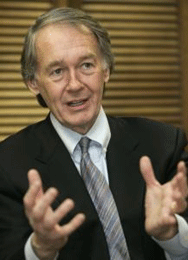
The climate bill's co-author, Rep. Edward Markey.
CURWOOD: From the Jennifer and Ted Stanley studios in Somerville, Massachusetts, this is Living on Earth. I’m Steve Curwood.
YOUNG: And I’m Jeff Young in Washington where a sweeping clean energy and climate change bill reached a milestone in Congress. The powerful House energy and commerce committee narrowly approved the bill by Democrats Henry Waxman of California and Ed Markey of Massachusetts.
CURWOOD: The Waxman-Markey Bill’s focal point is a cap and trade system for controlling greenhouse gases. And that’s also the focus of great controversy. Most environmental groups and some businesses support the bill, saying it’s the best chance to start cutting emissions at home and get the U.S. into an international agreement at talks at Copenhagen later this year.
Other activists say the measure doesn’t go far enough and that it’s trading system gives away too many of the valuable emissions credits.
YOUNG: Many industry groups and Republicans fought to kill the bill, and Waxman and Markey faced intense negotiations with moderate members of their own party. Democrats from coal country, the oil patch, and heavy manufacturing states were nervous about the bill’s economic impact. Waxman and Markey agreed to give electric utilities and some energy intensive industries most of the emissions credits they’ll need for free in the early years of the trading program.
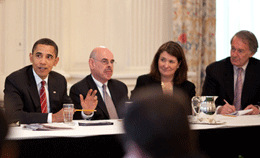
Rep. Markey(D-MA) (far right) discusses the climate change bill at the White House with President Obama, Chairman Henry Waxman (D-CA) and Rep. Diana DeGette (D-CO). (Courtesy of Congressman Markey)
MARKEY: Just the opposite. This bill has very strong targets. Seventeen percent reduction in greenhouse gases in the United States by 2020 and over 80 percent by 2050. It is a very ambitious bill. We’re keeping those targets intact. And in addition we have very strong goals for creation of renewable electricity in the United States, strong new building codes, 50 percent improvement in the efficiency of new buildings and on and on throughout the legislation – historic provisions that will transform the American economy and begin the process of backing imported oil out of our country.
YOUNG: But compared to say what our European partners are prepared to do – they’re talking about something like 25 to 40 percent reductions below 1990 levels in that early time frame 2020 target. Seems to me we’re gonna go to Copenhagen looking like we’re a lot weaker in terms of what we’re willing to do here.
MARKEY: The European Union is extremely cognizant of the fact that the Bush administration for eight years did nothing. That is why they booed the Bush administration at Bali two years ago. They understand why we’re behind. It’s not the American people. It was the Bush administration. So the goals that we’re putting together are very ambitious and that is something, which is appreciated by the European Union, by other countries in the world, and it’s why President Obama will go to Copenhagen as a hero.
YOUNG: You had to give away a lot of these emissions credits in order to win support. Were you surprised that you ran into that kind of resistance from Democrats and is there a concern that giving away those credits sets us up to repeat some of the mistakes that the Europeans did when they gave away a lot of the credits rather than auctioning them off?
MARKEY: We have factored in the mistakes that was made in the European Union. We always anticipated that it would be necessary to protect consumers from rate spikes and that is why some of the credits have been given away. We also knew that we would have to protect trade sensitive energy intensive industries. We don’t want the Chinese to be able to exploit a program meant in the United States to reduce our carbon footprint by having our steel, aluminum, paper and other trade sensitive industries destroyed by foreign competition over the first five to ten years. And so – no. All along Henry Waxman and I knew that we would have to build in transitional programs to help consumers, to help particular industries so that we made this transition in a way that did not harm our economy.
YOUNG: And is this as strong as this bill can get in terms of its emissions reductions targets? Is it kind of downhill from here, further compromises ahead when this hits the House floor or goes to the Senate?

Congressman Markey.
YOUNG: That’s energy subcommittee chairman Ed Markey, co author of the American Clean Energy and Security Act, which just passed the energy committee. The bill still has a long road ahead before the House takes it up, and the Senate, with its 60-vote threshold could prove even tougher political terrain.
Related links:
- Listen to an interview with Democratic Congressman Jay Inslee (D-WA).
- Listen to more of Jeff Young’s interview with Congressmen Markey.
- Read an analysis of the bill’s emissions reductions by the World Resources Institute.
- Read about the American Clean Energy and Security Act and its amendments here.
Greenhouse Gambling
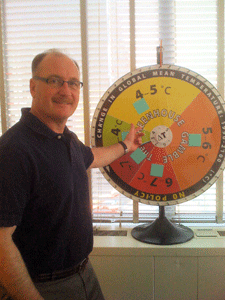
John Reilly and the MIT Greenhouse Gamble. (Photo: Steve Curwood)
CURWOOD: As the climate change bill works its way through Congress, new research at the Massachusetts Institute of Technology is showing that time for effective action on global warming is running out.
MIT scientists were so startled by the results of their latest efforts at climate modeling that it took them nearly three years of checking and double checking before publication—
If no action is taken the MIT group now expect temperatures to increase twice as much as previously thought.
Mixed in this forecast are probabilities of the likelihood of particular climate outcomes, and to illustrate the odds of risk, the MIT Global Change Program has built a wheel of chance. It looks like something Vanna White would spin on the Wheel of Fortune, and the scientists call it the Greenhouse Gamble:
REILLY: When you spin it, if you get unlucky you get high temperatures, and if you get lucky you get low temperatures. And it really signifies what we as humanity are doing, we're spinning a wheel, by putting emissions up in the atmosphere and we don't, at this point, know where it will stop.
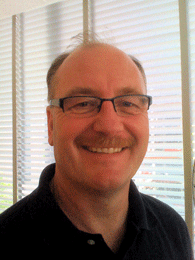
MIT economist John Reilly. (Photo: Steve Curwood)
[SPINNING SOUND]
CURWOOD: First, we spun the wheel to see how much hotter the planet might get by the end of the century if we do NOTHING to cut our greenhouse gas emissions.
[SPINNING SOUND]
REILLY: Okay, you've landed on the thing that says five to six degrees centigrade, a pie wedge that says that. That’s actually about the median forecast of what we’re getting. In the previous work we were thinking the median was more two and a half degrees and the highest, highest amounts we got approached five degrees. So now we have more than half of the wheel at above five degrees. So, you know, that is really a hot planet. [Laughing]
CURWOOD: So what’s happened to change your estimate of what’s going on? Is it that we’ve dumped more carbon into the atmosphere since you first did the study or are you getting better in your studies or what?
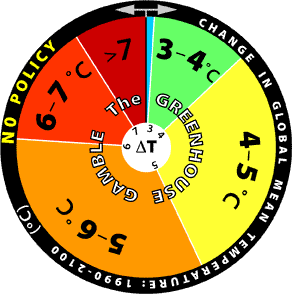
If we continue our current emissions path, we’re likely to see average global temperatures increase by at least five degrees Celsius.
CURWOOD: Alright, let’s give it another spin here.
[SPINNING SOUND]
REILLY: Oh this is not good. I’m sorry. The is all the way up to six to seven degrees assuming that we do nothing about climate change. So this is a really severe outcome. You know, combine that with seven degrees, it’s a twenty percent chance. And a twenty percent chance of going that high is a pretty large risk of pretty catastrophic results.
CURWOOD: Alright, now let’s give it a spin based on what you would call – what – very strong action, sharp reductions.
REILLY: Yes, this is the sort of wheel we’d be facing if we moved ahead with some of the bills in Congress now, and the U.S. did that and the rest of the world followed along with similar sorts of things. This is the sort of wheel we’d be facing if we actually adopted that policy.
CURWOOD: So what do you say – let’s give it a spin.
REILLY: Sure.
[SPINNING SOUND]
REILLY: So in this spin we’ve done as well as we can possibly do with this policy, and we’re still getting one to two degrees of warming. So that’s kind of the minimum we can expect if we are really aggressive to reduce greenhouse gases and we get really lucky.
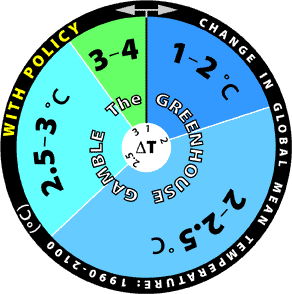
If we cut emissions, we’re still likely to see average global temperatures to increase by more than two degrees.
REILLY: About fifteen or eighteen percent of getting in that slice.
CURWOOD: So in other words, if you do the flip side of that, even with aggressive action we’re looking at better than eighty percent chance that we’re heading into a very uncomfortable zone.
REILLY: More than two degrees.
CURWOOD: And what would it mean if global average temperature went up by two degrees or three degrees centigrade?
REILLY: Temperature increases of two to three degrees are thought to be the point where you’d have ice free Artic and melting of the Greenland Ice Sheet or West Antarctic Ice Sheet, could raise sea levels by meters. And so that would be a very dramatic change. How fast that would happen is unclear, but once we get to that level, we’ve really then started probably an irreversible process.
CURWOOD: So these numbers are all based on going forward from today, but we already have – what- seven, eight tenths of a degree centigrade warming in the atmosphere.
REILLY: That’s correct.
CURWOOD: So, what are the odds of pretty much keeping the climate regime that we’ve got today?
REILLY: Well, there’s no chance of that. [Laughs] Even if we stopped all emissions of greenhouse gases this minute, there’s inertia build in the system that would continue to have warming of as much as a half of a degree between now and 2050 without anymore increase in greenhouses gases. And there’s no way the world is going to turn on a dime and we’re all going to stop driving our cars and turning on our lights tomorrow. And so even with the most intense efforts to reduce greenhouse gases, there’s going to be more emissions.
CURWOOD: Somebody listening to us might say “Huh, okay. So like we have an 80 percent chance of things being really very difficult, even if we have aggressive policies. Why bother?” What would you say to them?
REILLY: If we don’t bother it’s going to be much, much worse. In this debate there’s this idea that we’re already gone over a cliff or something and that leads to the frustration that, well, if we’ve gone over the cliff, why bother? Unfortunately there may be little cliffs, but there’s many more cliffs to come. And so, we’re stuck with, I think, probably something on the order of two and a half to three or four degrees warming even if we do almost everything we can. So we’re gonna have to be prepared for adapting to the climate change we see and really worry about, you know, risk to agriculture, to coastal systems, to severe storms, to increased hurricanes, to melting of ice. The risks are there and I think they’re, at this point, some of them are unavoidable, but we certainly want to move ahead as fast as we can to avoid these really catastrophic outcomes.
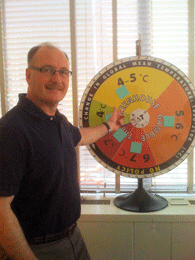
John Reilly and the MIT greenhouse gambling wheel. (Photo: Steve Curwood)
REILLY: Well, you know, we scientists we’re ducks, right? So, this is an incredibly fascinating problem for us [laughing]. So, it’s an interesting research topic. So, I guess I still sleep, but [laughing] I try not to think about what the real consequences are.
CURWOOD: John Reilly is with the Climate Modeling Group at MIT. Thank you so much.
REILLY: Thank you.
[MUSIC: Carlos Santana “Blues For El Salvador” from Multi Dimensional Warrior (Legacy records 2008)]
YOUNG: Coming up – an egg hunt to help birds survive farm country. Keep listening to Living on Earth.
[CUTAWAY MUSIC: Thomas Marriott “You Only Live Twice” from Flexicon (Origin Records 2009)]
Related links:
- For more on the Greenhouse Gamble, click here.
- Click here for more on the The MIT Joint Program on the Science and Policy of Global Change.
Kick Starting Better Mileage
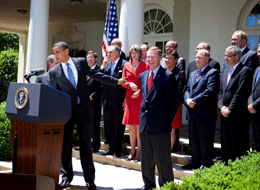
The President acknowledges Ford CEO Alan Mulally during the announcement on fuel-efficiency standards. (Photo: Samantha Appleton, Courtesy of the White House)
YOUNG: When President Obama brought the heads of the top automakers to the White House to announce new fuel efficiency standards, it was clearly big news for the auto world.
But implications for the rest of the planet are still sinking in. Each company’s cars and light trucks will have to average 35 and a half miles per gallon by the year 2016—much sooner than under current law.
The groundbreaking standards also bring the nation’s first federal regulation of greenhouse gases by applying the limits on CO2 from tailpipes that California and other states had fought for in court.
The President says the savings will be big: a cut in oil use greater than what the U.S. now imports from Saudi Arabia; and a drop in CO2 emissions equal to taking 50 million cars off the road.
OBAMA: Ending our dependence on oil, indeed, ending our dependence on fossil fuels, represents perhaps the most difficult challenge we have ever faced -- not as a party, not as a set of separate interests, but as a people. We have over the course of decades slowly built an economy that runs on oil. It has given us much of what we have -- for good but also for ill. It has transformed the way we live and work, but it's also wreaked havoc on our climate. It has helped create gains in prosperity unprecedented in history, but it also places our future in jeopardy.
YOUNG: Dan Becker was at the White House Rose Garden for that announcement. He’s spent two decades fighting for cleaner cars as an advocate with the Sierra Club and now his Safe Climate Campaign. I sat down with Becker to talk about cars and climate, and I asked him what it meant to witness this breakthrough moment in one of Washington’s oldest environmental fights.
BECKER: Oh it felt wonderful. After twenty years of fighting the auto industry, seeing the CEOs lined up in a tableau behind the President with some cabinet members and some Congresspeople – I turned to somebody and said, “It’s the good, the bad and the bankrupt.” But it really felt good. You know, I think this is a very important step forward.
YOUNG: Give me a sense of how this came together. It was just a few months ago that the industry was still fighting in court tooth and nail against this. What provided the break through? I’m guessing it has something to do with the fact that many of the major automakers were coming to Washington hat in hand to save them.
BECKER: Well it’s hard to yield the bludgeon on environmental rules when you’re shaking the tin cup in the other hand. The bailouts and the bankruptcies certainly have put pressure on the auto companies. But they’ve also run out of rope. The Congress rejected their pleas in 2007 to oppose CAFE standards and they passed the law. The Supreme Court rejected their pleas and sided with us in the Massachusetts vs. EPA case that said EPA should go ahead and regulate global warming pollution from automobiles and that states like California could go ahead with their rules. And, of course, they want vast sums of money from taxpayers. So it behooves them to act as if they get it.
YOUNG: Well, what do we know about the kind of vehicle fleet that might result when automakers, you know, have to meet this new standard?
BECKER: Well, the vehicles probably won’t look very different, because at ten miles per gallon improvement ninety plus percent of the vehicles will only change under the hood. The engines will run the car further on a gallon of gas, the transmission will allow you to shift more efficiently, the aerodynamics will push less air out of the way when you accelerate on a highway. All of those are things that can dramatically improve fuel economy and they’re all technologies that have been sitting on the shelves for the last twenty years. In the next round, the post 2016 round, that’s when we can begin a much more dramatic shift to advanced technology vehicles that run on a different kind of system that the internal combustion engine. We have to get there. But this is just a first step preliminary to that.
YOUNG: Shifting gears here slightly, pardon the pun, but what does this mean for the President’s larger strategy for addressing climate change, especially with an eye toward these international talks coming up at the end of the year?
BECKER: There are three moving parts here: the Copenhagen Treaty that you refer to, there is legislation currently on Capitol Hill, and there are the existing laws like the Clean Air Act that the President is using to raise these standards. The President is working on the last. For the purpose of the treaty negotiations, the U.S. has to come to Copenhagen with some real accomplishments and be able to point to those and say “look, we know we’ve been absent from this debate in the last eight years, but now we’re back in the game. And here are real emissions reductions that we can show you that show that we in the United States are committed to curbing global warming. And, by the way, if you’ve been hiding behind us and our inaction, those days are done.”
YOUNG: Let’s talk about cost. I’ve read estimates that meeting this will require something in the range of an additional $1300 per car, on average. How does that work for consumers?

The President acknowledges Ford CEO Alan Mulally during the announcement on Corporate Average Fleet (CAFÉ) standards. (Photo: Samantha Appleton, Courtesy of the White House)
YOUNG: It’s a little sad, isn’t it, that it took the crippling of our domestic auto industry, basically, to bring this about.
BECKER: It is really tragic that the auto industry couldn’t bring itself when it was in its prime to make clean cars that Americans want and that are good for our society. We all remember, “What’s good for General Motors is good for the nation.” Well, they finally found out that what’s good for the nation is actually what’s good for General Motors. And hopefully they will be able to rebuild themselves by making the clean cars that foreign manufacturers make and sell, but that the American manufacturers had not.
YOUNG: That's Dan Becker with the Safe Climate Campaign. You can learn more about the new auto standards at our website, loe.org.
[MUSIC: Tom Verlaine “Old Car” Warm And Cool (Thrill Jockey Records)]
Related links:
- Read the Union of Concerned Scientists report on available technology to boost fuel economy.
- Click here for the Auto Alliance statement on the fuel economy agreement.
- Read the President’s remarks on announcing the new fuel standards.
Gators Find Solar Power a Slam Dunk
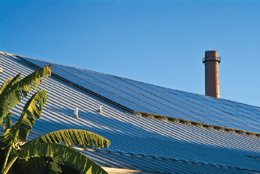
Gainesville Regional Utilities is responsible for the power plant in the background, and the photovoltaic panels in the foreground.
YOUNG: It’s Living on Earth, I’m Jeff Young
CURWOOD: And I’m Steve Curwood.
One section of the Waxman-Markey climate bill would require that utilities generate at least a portion of their power from renewable sources. One city-owned power company in Florida is already way ahead, loading up rooftops with solar panels.
Ed Regan is the assistant general manager for strategic planning at the Gainesville regional utilities and he says the renewable energy path for the sunshine state is obvious.
REGAN: What we’ve got in the South is sunlight and biomass, plenty of sunshine and a lot of growing things. And so that’s what we’re trying to harness over here in Gainesville, Florida.
CURWOOD: So, let me see. The basic idea here as I understand is this: The utility you work for collects a certain amount, about 74 cents a month extra from all of its customers and then uses that money to pay an attractive bonus to your solar customers for every kilowatt they pump into the electrical lines.
REGAN: Yeah. What’s very different about the approach that we’ve taken and that’s very common in Europe and other parts of the world is rather than saying, well, let’s only value solar electricity as the fossil fuel that it will replace. We kind of turn that equation over and say what do we have to pay to make it a good investment. So you put a solar panel on your roof, you hook it directly to the utility company, and we buy all your output and we use it to serve all of our other customers.
CURWOOD: So, let’s go through the math here. If I were buying electricity from your utility, how much do I pay per kilowatt-hour?
REGAN: If you were a residential customer about 13 cents.
CURWOOD: And if I were to supply solar from my roof what would you pay me?
REGAN: 32 cents.
CURWOOD: That’s a pretty good deal. So this apparently has changed the calculation for those big roofed businesses and homeowners I imagine.
REGAN: Absolutely.
CURWOOD: Folks will say, hey I can put in solar, get rid of my electric bill, the utility will help me pay back the hefty cost of the installation. I may even make some dough here.
REGAN: That’s right.
CURWOOD: So can you give me a typical scenario please?
REGAN: Oh a typical scenario is a grocery store or one of those big box pharmacies or an auto repair shop or a tire shop will put a fairly large array on their roof. This really works out very well if the owner of the system is a company that would be paying federal taxes because there’s a lot of tax benefits that go with it. If you’re a school or a church, you don’t get those benefits, so even with our feed-in tariff, it’s not going to be a very lucrative investment. However, you have the opportunity to lease your roof to somebody that can get those benefits and that’s going on as well.
CURWOOD: So what about the private homeowner who does pay federal taxes. Solar systems aren’t cheap – how can they afford the up front money to put something up there to capture that sunlight? What are my odds of getting a loan from the bank to put that thing up there?
REGAN: Depends on your credit rating, but I’d say it’s pretty good – at least in Gainesville because they’re starting to become used to it. There’s really two key aspects to our program. The first key aspect is we give you a price that’s gonna make it work and it’s 32 cents. The next key aspect is we give you a contract, and the contract says we’re gonna pay you 32 cents per kilowatt hour that you make for the next twenty years, and it’s backed up by the full faith and credit of Gainesville Regional Utilities. With the contract, with the interconnection agreement and your good credit rating, this is a really nice investment because the contract is – you can use it as collateral.
CURWOOD: So why do you want to do this? I mean what’s the benefit to you the power provider here?
REGAN: First of all our city commission has adopted a policy of meeting the Kyoto Protocol, which means that we need to get a substantial amount of renewable energy. The second thing is the community really is committed to doing what they think is right in terms of reducing CO2 emissions because of their contribution to greenhouse gases. And thirdly, it’s really surprising what this has done in terms of employment opportunities, enthusiasm, the whole moral of the community. I’ve had the head of the Electric Workers Union come up to me and say “Gosh, thanks. Everybody’s got a job.” Its huge amounts of investments going on and it’s just good for the community from that point of view.
CURWOOD: So Ed, tell me. Why do you think the utility you work for – this is the Gainesville Regional Utilities – sees a benefit in fostering a local solar industry enough to become really the first place in the U.S. to do this on a major scale – yet, other utilities, so far, do not.
REGAN: Well Gainesville is kind of a special place. It’s the home of the University of Florida, the Fighting Gators. We have a very environmentally aware community. We have a city commission that’s well in-tune. And we’ve been undergoing a very vibrant energy supply discussion since about 2003. We generate all of our own electricity and we have a coal plant. We own a piece of a nuclear plant. We have gas plants. And in 2004, the staff actually recommended a new coal plant, and that started a lot of discussion about climate change, global warming, various forms of renewable energy and that’s how we got to where we are now. And, you know, I’ve been in the utility business thirty years and I’ve been through a lot of rate increases and things like that and I think we’re all very surprised at how accepting our customers have been and how very, very little push back we’ve gotten in terms of – they know their bills going up a little bit, but they see the benefit of it – they like it. My experience with our community is that people really care about the environment and they want to do the right thing.

Gainesville Regional Utilities is responsible for the power plant in the background, and the photovoltaic panels in the foreground.
REGAN: That’s right. I think an investor owned utility would really have a hard time doing this because those regulations are all pointed in one direction, and that direction is lowest cost.
CURWOOD: Educate me for a moment, Ed. How many municipal power districts are there in the country that could start doing this if they wanted?
REGAN: Over 2000. I think they represent about fifteen percent of the United States load, electrical. And then there’s probably another ten percent that’s the co-ops that would probably have a similar option.
CURWOOD: So, in other words, a quarter of America could go down this path without regulatory change?
REGAN: Yeah, that’s about right.
CURWOOD: So what advice do you have for people who are listening who might want to get a similar offer from their power companies?
REGAN: Well, find out who does the planning and take ‘em to lunch.
CURWOOD: Ed Regan, thanks so much for speaking with us today.
REGAN: Well, it’s been a real pleasure.
CURWOOD: Ed Regan spoke to us from his office at the Gainesville Regional Utilities where he is the assistant general manager for strategic planning.
Related links:
- Click here to learn more about feed-in tariff’s.
- For more on the Gainesville Regional Utility and its solar feed-in tariff program, click here.
Duck Egg Rescue

Rescuing duck eggs from crop cover. (Photo: Brent Holland, Blue Lab Media)
CURWOOD: Now greener cars may help save the planet, but every day gas-guzzlers and hybrids alike kill thousands of wild animals.
Agriculture also has its own version of road kill. If creatures nest in plantings, they face disaster when farm machines come through. Ducks are especially fond of nesting in vetch, that’s a cover crop many farmers plant to boost soil nitrogen, and nests often get crushed.
But one family farm in the Sacramento Valley has found a solution. Just before it’s time to turn the soil in the spring, an army of volunteers retrieves as many eggs as possible. It’s called 'Egg Aid', and this year, reporter Beth Hoffman went along.
[CROWD SOUNDS]
VOICE OVER LOUDSPEAKER: If everyone, if everybody will gather around here…
HOFFMAN: Egg Aid is a little like the biggest, hardest Easter egg hunt you've ever done. It takes place in the overgrown rice fields of Lundberg Family Farms. This year about forty kids and twenty adults came out for the search.
LUNDBERG: (over megaphone) Now I just would like to make a little identification for you about what some of these cover crops are…
HOFFMAN: But today the kids don’t only learn about duck eggs. They also hear about growing rice organically, as the Lundbergs do. Bryce Lundberg holds up a tall plant with yellow flowers for the crowd of squirmy kids to see.
LUNDBERG: (over megaphone) That one there might be something you put on a hamburger or hot dog besides ketchup. Something yellow. What might that be?
KID: Mustard
LUNDBERG: (over megaphone) Mustard – that’s right.
HOFFMAN: The Lundbergs and other organic farms don’t just plant a cover crop for winter. They let the mustard and vetch grow in the fallow field for a whole year. By that time it’s three or four feet high, and provides great cover for ducks to lay their eggs.
KERHOULAS: (over megaphone) There are a lot of eggs and a lot of nests in this field and you’re going to be surprised how hard some of them are to find.
HOFFMAN: This is Gary Kerhoulas, a volunteer organizer for Egg Aid. The idea for the egg search is to startle the ducks, then make your way to where the hen took off and look for a nest. The kids all grab hold of a long rope, strung with coffee cans full of rocks. Four wheel ATVs come up behind, carrying empty egg cartons. Then Kerhoulas gives the go ahead.

Children prepare for the rescue mission. (Photo: Brent Holland, Blue Lab Media)
[NOISE OF CANS]
HOFFMAN: The kids walk and shake the rope as they go. The noise is deafening, and it’s a wonder every duck for a hundred miles doesn’t immediately fly away. But they don’t, and only when the line gets close do they suddenly shoot off.
BOY: Look on the ground, there are going to be eggs over here.
HOFFMAN: The kids search in the cover, gently moving the chest high brush aside.
[KIDS YELLING]
KID: Oh, my God!
[SOUND OF KIDS LOOKING FOR EGGS, THEN CHEERING]
CROWD: We found them. Woah! Way to go John!
[CLAPPING]
KID: We found a big one!
HOFFMAN: It’s thrilling to find a nest, the eggs slightly blue, and still warm. A soft layer of down covers them, and the kids pick them up and gently put them in the egg carton.
[MORE SOUNDS OF EXCITEMENT, FINDING NESTS]
FATHER: Do you want to pick them up and hand them to me?
GIRL: Yeah, yeah, yeah
FATHER: Okay, gently, just like our chicken eggs.

Children place their findings in an egg carton for safe transport. (Photo: Brent Holland, Blue Lab Media)
LUNDBERG: And we felt almost guilty of destroying those eggs, but there was nothing we could do about it. And so we started having the men on the tractors carrying these egg cartons, but it got really more than they could do.
HOFFMAN: So a wheat farmer who lived near by – Darrel Daly – came up with the idea of saving eggs, and began hatching them at his home. Now in fact his main work is the hatchery.
DALY: I was running a wheat harvester and I ran over a mallard nest, smashed about half the eggs and I took them home and hatched out four and released them into the wild. And then the next year the neighbors would come with a hat full of eggs, and from four it’s turned into some years over 2000.
[SOUND OF CANS]
HOFFMAN: By lunchtime the kids were tired and hungry. But they had also found lots of eggs.
GIRL: A little girl found a nest of six.
GIRL: And we found a nest of black birds too.
GIRL: Three of them.
HOFFMAN: It is hard to say whether the excitement of finding duck eggs will turn these kids into supporters of organic food. But eleven-year-old Lexi sounds like she’ll remember this day for a while.
LEXI: I was really excited. I was like “Oh my gosh, I found the eggs!” And we all got to pick up the eggs and feel how warm they were and stuff. Yeah, I learned that you could save lives, really easily. Yeah, that was really exciting for me.

Scaring away the ducks. (Photo: Brent Holland, Blue Lab Media)
[MUSIC: Andrew Bird “Masterswarm” from Noble Beast (Wegawam Records 2009)]
YOUNG: Just ahead: batting clean-up for the green work force. Stay with us - on Living on Earth.
ANNOUNCER: Support for the Environmental Health Desk at Living on Earth comes from the Cedar Tree Foundation. Support also comes from the Richard and Rhoda Goldman fund for coverage of population and the environment. And from Gilman Ordway for coverage of conservation and environmental change. This is Living on Earth on PRI, Public Radio International.
[CUTAWAY MUSIC: Spyro Gyra: “A Distant Memory” from Down the Wire (Heads Up 2009)]
Related link:
For more on Lundberg Family Farms, click here.
Going for Dirty Green Jobs
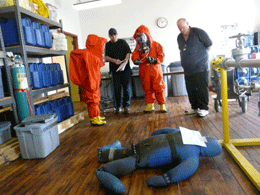
Hazmat to the rescue. (Photo: Bruce Gellerman)
CURWOOD: It’s Living on Earth. I’m Steve Curwood
YOUNG: And I’m Jeff Young.
President Obama wants to create five million new jobs in clean energy, clean technology and environmental clean-up. And though many people are looking for jobs, few have the right skills and few places exist to teach them.
Living on Earth’s Bruce Gellerman found a program in Massachusetts that is already specializing in green job training, and has our report.
GELLERMAN: Gary Kaplan is something of a leading economic indicator. As Executive Director of the Boston based non-profit JFY Networks it’s been Kaplan’s job for the past three decades to anticipate the jobs of the future and then create work force training programs to meet the demand.
When biotechnology was heating up JFY Networks taught biotech skills. When financial services began booming, it provided training in that.
KAPLAN: So the industry comes to us and the industry in effect says “we need people with these kind of skills and we need them in about two months. Can you deliver them?” And we say, “Okay. So what do we need? We need some of this and we need some of this some of that.” We pull all of this together and that’s a workforce development program. We do what the industry asks for. If the customer wants pink, you do pink. When the customer decides he wants blue, you do blue.
GELLERMAN: Today, companies want green. The mantra is green jobs for blue-collar workers. But Kaplan says, the U.S. educational system is ill equipped to provide the specialized training for the emerging green economy.
KAPLAN: We have a huge problem with workforce development. If we’re going to have a growth of all these green technical industries we need a tremendous number of people with technical skills. We’re not producing them.
GELLERMANL Just fifteen percent of the nation’s high school students are enrolled in vocational education and just a small fraction of those get training in green technologies - and a similar percentage of university and college students graduate with degrees in the so-called STEM subjects - Science, Technology, Engineering, and Math. That’s where Kaplan’s JFY Networks comes in. It brings together vocational ed, higher ed and industry to form an ad hoc network that provides specialized training, and more importantly, certificates in emerging fields.
These days JFY Networks does work force development in the hazardous materials industry: cleaning up asbestos, toxic waste, mold, and chemical spills. Students completing the fourteen-week course receive seven different federal occupational safety certifications or what industry insiders call: “HAZWOPER certs.”
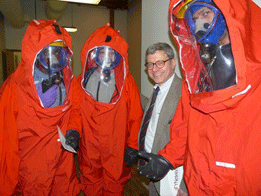
Gary Kaplan (not in uniform), executive director of JFY Networks, with Hazmat trainees. (Photo: Bruce Gellerman)
[PEOPLE MILLING]
MACE: Well, we’re getting suited up to respond to a Hazmat situation.
GELLERMAN: Mike Mace wriggles into a gray plastic jump suit. He’s one of eighteen students at this JFY HAZWOPER certification class at the University of Massachusetts in Lowell.
MACE: This is a splash suit - and it protects you from having hazardous chemicals splashed on you. This is a cartridge respirator these are rubber boots - contaminant boots - splash proof boots.
GELLERMAN: Mike Mace, like half the participants in this class already has a job - some even have college degrees. Their companies are paying to get them their HAZWOPER certs. The other participants are with JFY Networks. The cost to them is nothing - the fourteen-week course is funded by the federal Environmental Protection Agency.
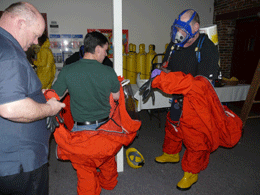
Getting suited up. (Photo: Bruce Gellerman)
GELLERMAN: Mike Fitts, one of the hazmat trainers barks like a drill sergeant as the green recruits pour over bookbinders and rehearse procedures.
FITTS: You’ve gotta know what gets you hurt when you’re putting the suit on and going in there. The PEL for ammonia is 50. It’s a skin hazard at about 1800 for most people. So at 1500 most places put you in to level A.
GELLERMAN: A short pep talk and Fitts deems the trainees ready to take their practical exam: cleaning up a mock hazmat emergency.
FITTS: We’ve gotta put them in their prom dress because it’s time to dance.
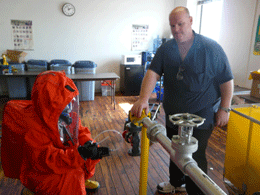
Hazmat instructor Mike Fitts supervises a mock clean-up. (Photo: Bruce Gellerman)
FABIAN: So we’re just waiting until we get the OK. Then we’ll finish suiting up and then we’ll be good to go.
GELLERMAN: Boy, that can’t be any fun to work in.
FABIAN: No, but I take my time, you know, I want to learn all the procedures the right way. It doesn’t bother me. You know, taking it easy. I’ve learned a lot of stuff in here.
GELLERMAN: What were you doing before this?
FABIAN: Laid off…unemployment. I want to start a career that doesn’t get shipped over seas, you know. And I’m always the type of guy who likes to jump into new things.
TRAINERS: Listen up. Let’s get the team leaders, the team leaders, Jim Terrance, Darleen…
GELLERMAN: The trainers divide the eighteen HAZWOPER hopefuls into three teams. Each will face a different scenario. Instructor Mike Fitts tells one team a pipe at an ice cream company is leaking a gas - possibly ammonia. The second team has to deal with barrels abandoned by a bankrupt chemical company.
[PEOPLE TALKING AND PREPARING]
FITTS: …And then the third group has got an area around the corner here where we dropped a bunch of popcorn, packing popcorn to simulate bird droppings - that the birds came in thru an open broken window and they have a biological hazard. So they’re forming into three teams to deal with those three hazards.
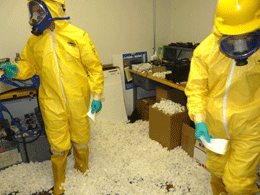
A clean-up scenario simulating bird droppings. (Photo: Bruce Gellerman)
FITTS: For them? Coming from a background where they don’t have any chemical knowledge at all, trying to learn what the chemical hazards are. And what we try to drive home is safety so they’re safe on the job. That’s our goal.
[SOUNDS OF TEAMS TALKING]
GELLERMAN: The JFY participants receive a semester of college chemistry and lab credits. The hands-on part of the course employs what hazmat instructor Jimmy Smith calls: “the popular ed method.”
SMITH: We start with the concept that everybody – adults – all of them come with some knowledge, they just don’t know how to direct that knowledge, right? So we give them the linkage to pull that knowledge together so they can make decisions. And some of them have never had chemistry and we break it down to them. And it’s really interesting to see the light bulb turn on to them and say, “I got it…Eureka!”
GELLERMAN: JFY student Andrew Hopper hasn’t yet found that moment. So before his team sets out on their mock hazmat scenario he steals a few seconds to hit the books.
HOPPER: We’re on the decontamination team so we’re just looking at how to do it again.
GELLERMAN: You’ve got a loose-leaf binder here. Quite a big loose-leaf binder actually - a lot to learn?
HOPPER: Well, they go over a lot of it. There’s so many acronyms - I couldn’t tell you how many. There’s a lot of them.
GELLERMANL: OK - this one says positive pressure S C B A- this is a test. What’s S-C-B-A?
HOPPER: It’s your self-contained breathing apparatus. It’s what you need for a level B atmosphere. It’s a level B suit. And you can have it for level A, but a level A is fully encapsulated so it’d be inside the suit with you - level B it’s on the outside.

(Photo: Bruce Gellerman)
HOPPER: No, I didn’t.
GELLERMAN: The pace picks up. The teams spread out around the building and JFY trainee Clarence Proctor pulls on his air mask and hood.
PROCTOR: Yeah, we’re going in on biohazard - bird poop can become a real problem. It gives off ammonia. It can knock you out.
GELLERMAN: Then as an instructor looks on Proctor cautiously enters the room and begins taking readings of the air.
PROCTOR: Oxygen is 19.2 …no just 19 he says
SMALL: 19.2?
GELLERMAN: That’s Thai Small on the walk-talkie. She’s working on Proctor’s backup team.
SMALL: They tell me different levels of the IDLH, the LDL. Right now we have hydrogen sulfide in there. So I’m trying to protect them from that.

Hazmat to the rescue. (Photo: Bruce Gellerman)
SMALL: No, not at all, not at all. But this is a good program, it’s a good opportunity. Before I was in this program it was real hard looking for a jobs and things like that. But since I’ve been in this program it’s a real good opportunity. You learn a lot. The hands-on is excellent, so I’m real excited about it.
GELLERMAN: The JFY trainees also go through mock interviews with perspective employers and learn how to write a resume. Based upon past classes, Larry Elgart, Marketing Manager at JFY Networks, predicts 80 percent of these students will graduate.
ELGART: People will wash out during the program. We simulate this program exactly like going to work. We tell folks you’re not coming to training, you’re not going to school you’re coming to work. So I hold somebody to the exact same standard as someone on my staff. So then when they get into the workforce it’s a seamless transition.
GELLERMAN: The idea behind JFY Networks is simple, says Executive Director Gary Kaplan - turn hazmat training into a three-letter word.
KAPLAN: It’s a job. It’s a dirty job but it’s a job. J-0-B - it’s a job. It has a paycheck attached to it. It also has security attached to it. These jobs cannot be sent off to China. There’s no business cycle here. It doesn’t matter if we’re at the bottom of a depression. When something gets spilled, you get sent out to clean it up. And we’ve had a lot of people say things like “you know I go home and my children say, ‘Gee dad you’re cleaning up the environment.’” You know, they’re in the green movement.
GELLERMAN: And with so much federal green in the economic recovery package aimed at job training programs. Gary Kaplan is planning to expand the JFY Networks’ offerings to include certification courses in energy efficiency and renewable energy.
For Living on Earth, I’m Bruce Gellerman.
[MUSIC: The Orb “It’s A Beautiful Day” from The Dream (Six Degrees Records 2008)]
Related links:
- For more about JFY Networks, click here.
- Learn more about OSHA Hazwopers here.
- Check out the President's green jobs plan.
Tiny House
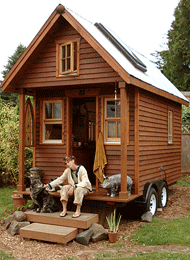
Dee Williams sits on the porch of her dream house.
CURWOOD: Dee Williams lives in a tiny house. It’s just 84 square feet. She designed its layout on an area rug in the dining room of her previous home, a three-bedroom house in Portland, Oregon.
Her new house is on wheels but it is generally parked in a friend’s yard. She says she wanted to engage more in her community and reduce her carbon footprint. She’s also reduced her monthly expenses from fifteen hundred dollars to about five dollars – the costs of propane to cook and heat her new home.
Dee, now you were living in a nice bungalow when you decided to pack it all away and drastically downsize. Why?
WILLIAMS: Well I think a part of it was just wanting to do an experiment on myself. I had taken a trip to Guatemala and on that trip, you know, it was like a big spanking, you know. I bumped into all these folks in Guatemala who were just incredibly generous and had absolutely nothing. It was kind of this comparison thing that kinda brought home with me and then also, you know, just kind of taking a look at my world and realizing that our mortality is a real thing and if I did want to shake it up, I needed to do that.
CURWOOD: So I’m wondering if you can take me for a virtual tour of your home. Here I am standing in front of it. What do I see and what would happen if I walked through the front door?
WILLIAMS: Well, my little house looks like a little cabin, so its got a pointy little roof, a very small door – it’s like two feet wide. I pulled that out of a dumpster and it’s gorgeous. And a little front porch. And there’s a sleeping loft above the front porch so that kind of creates this little nook of the front porch. Walk inside – after you take your shoes off – and turn to the left: there’s the kitchen counter. And I have a crock that I carry water into the house and there’s a sink that drains into a jug under it. If you turn to the right, there’s a toilet and where I keep all my booboo dust.
CURWOOD: Booboo dust?
WILLIAMS: Booboo dust. In the Pacific Northwest those are cosmetics.
CURWOOD: Oh excuse moi.
[LAUGHING]
WILLIAMS: So you take a couple of steps and you’re out from underneath the sleeping loft. And you’re standing in this – what I call the great room. Its about a six by six foot space and has an eleven foot ceiling with a big skylight, and that’s my living room. I would make you crawl up into the sleeping loft to try it out because its incredibly spacious even though you can’t stand up there. There’s another skylight that’s over the bed, which is just an incredible gift, I mean, there’s nothing like being able to fall asleep staring at the stars or the moon or watching it rain.
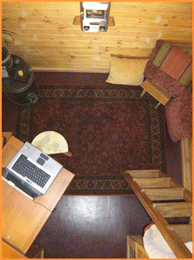
A view from the sleeping loft of the great room. (Courtesy of Dee Williams)
WILLIAMS: It’s just the footprint of the bottom. I guess the rule of thumb for architects is that if you can’t stand up in a space, you don’t have to count it. So I think if I was to pull a real estate ad it would be one bedroom with a bonus room. I would be like a quarter bath or something like that because [laughing] I just have a toilet. I don’t have a sink.
CURWOOD: Talk to me about exactly how you built this. You have obviously some building skills yourself, you have some carpentry skills. As I understand it you got some shingles from a friend who stored them long ago, but where’d you get your other stuff?
WILLIAMS: I scavenged a lot of stuff out of debris piles, so the roof of the porch, the overhangs, the soffits, all of that is salvaged. The skylights came from a salvage yard. The kitchen counter is an old pocket door, the wood that’s on the walls, it’s knotty pine – that came from a habitat restore and the loft flooring came out of a house fire. It’s like the house kinda grew out of what was made available. It’s kinda cool to be able to live in a space that tells more of a story than I went to Home Depot and I got a great price on this.
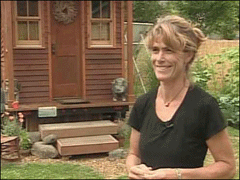
Dee Williams.
WILLIAMS: I have a composting toilet. So I’ve got these new chores that are a part of living in an 84 square foot house. Managing my compost is one of them. Dragging water into the house for washing dishes and stuff like that is another chore.
CURWOOD: Okay Dee. How does one scale down from a three-bedroom house to something that is, you know, twelve by seven essentially?
WILLIAMS: I had to do it the hard way. I had to go through everything. [Laughing] I had like three piles: one pile was the stuff that was definitely gonna get dragged out to the curb and it was massive, it was like, you know, the moldy old ice cube trays and saggy futons and, you know, linens and garden tools. I got rid of all of that stuff. And it was pretty easy. I haven’t wondered, you know, “Gosh, you know, I wish I still had all of that silverware that didn’t match that I’ve been dragging around since college. That stuff was great.”
[LAUGHING]
CURWOOD: Okay, so – threw stuff out – and then?
WILLIAMS: And then, you know, I was left with the stuff that was just overwhelming to try to figure out. You know, the old love letters, trophies. So I put those in four of those – you know those plastic kinda of bins? Over the years I’ve gotten it down to about a fourth of one.
CURWOOD: Okay, well what about going forward – Dee, I mean every day there’s stuff that we encounter that we think we need to have – what do you do with that?

CURWOOD: [laughing] Okay.
WILLIAMS: It’s been a really good lesson for me to learn how to accept people’s gifts and my friends have been wonderful at teaching me that.
CURWOOD: So, at what point do you think you might decide you don’t want to live in this small space anymore – or maybe decide that you want to downsize even further?
WILLIAMS: You know I have thought about downsizing even further only because there’s a lot of wasted space. And then more recently I’ve thought that’s foolish.
[Laughing] I’ll go nuts. I need at least 84 square feet.
[LAUGHING]
WILLIAMS: And then as far as, you know, moving on to something else, I think if I, you know, fell in love and decided I wanted to be with somebody over a longer period of time than a few nights, I would definitely need more space and I would like to think that I could take the stuff that I’ve learned in this giant experiment in the backyard and apply that to whatever living situation I have.
CURWOOD: Dee Williams lives in Olympia Washington – well, at least that’s when her tiny home is parked there. Thanks so much, Dee.
WILLIAMS: Thank you so much.
[MUSIC]
CURWOOD: To hear much more of our interview with Dee Williams, and to see pictures of her tiny home, go to our website: loe.org.
[MUSIC: Various Artists “ Our House” from Pickin On Crosby, Stills, Nash & Young Vol. 2 (CMH Records 2002)]
Related links:
- Listen to an extended version of Living on Earth’s interview with Dee Williams, and go backstage the LOE crew.
- Tumbleweed Tiny House Company
- Watch a Dee Williams YouTube video of her tiny home.
CURWOOD: Living on Earth is produced by the World Media Foundation. Our crew includes Bobby Bascomb, Eileen Bolinsky, Bruce Gellerman, Ingrid Lobet, Helen Palmer, Ike Sriskandarajah, and Mitra Taj, with help from Sarah Calkins and Marilyn Govoni.
YOUNG: Our interns are Lindsay Breslau, Liz Gross, Phil DiMartino and Christine Parrish. Jeff Turton is our technical director. Alison Lirish Dean composed our themes. You can find us anytime at loe.org.
I’m Jeff Young.
CURWOOD: And I’m Steve Curwood Thanks for listening.
ANNOUNCER: Funding for Living on Earth comes from the National Science Foundation, supporting coverage of emerging science, and Stonyfield Farm: organic yogurt and smoothies. Stonyfield pays its farmers not to use artificial growth hormones on their cows. Details at stonyfield.com.
Support also comes from you our listeners, the Ford Foundation, the Town Creek Foundation, the Oak Foundation supporting coverage of climate change and marine issues; the Skoll Foundation, supporting social entrepreneurs around the world – uncommon heroes dedicated to the common good. Learn more at skoll.org; and Pax World Mutual Funds: socially and environmentally sustainable investing. Pax World: for tomorrow. On the web at paxworld.com.
ANNOUNCER: PRI, Public Radio International.
Living on Earth wants to hear from you!
Living on Earth
62 Calef Highway, Suite 212
Lee, NH 03861
Telephone: 617-287-4121
E-mail: comments@loe.org
Newsletter [Click here]
Donate to Living on Earth!
Living on Earth is an independent media program and relies entirely on contributions from listeners and institutions supporting public service. Please donate now to preserve an independent environmental voice.
NewsletterLiving on Earth offers a weekly delivery of the show's rundown to your mailbox. Sign up for our newsletter today!
 Sailors For The Sea: Be the change you want to sea.
Sailors For The Sea: Be the change you want to sea.
 The Grantham Foundation for the Protection of the Environment: Committed to protecting and improving the health of the global environment.
The Grantham Foundation for the Protection of the Environment: Committed to protecting and improving the health of the global environment.
 Contribute to Living on Earth and receive, as our gift to you, an archival print of one of Mark Seth Lender's extraordinary wildlife photographs. Follow the link to see Mark's current collection of photographs.
Contribute to Living on Earth and receive, as our gift to you, an archival print of one of Mark Seth Lender's extraordinary wildlife photographs. Follow the link to see Mark's current collection of photographs.
 Buy a signed copy of Mark Seth Lender's book Smeagull the Seagull & support Living on Earth
Buy a signed copy of Mark Seth Lender's book Smeagull the Seagull & support Living on Earth

